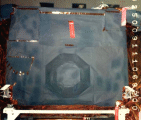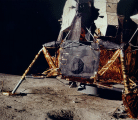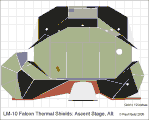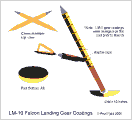Lunar Module Coatings PageOther >non-Eagle< LMsDetailingWhat follows is my attempt to pick a collection of images that show typical details on the Lunar Module. As the Grumman Thermal engineers learned more - especially through shock tunnel testing - they evolved thermal coatings to fit each mission. The tough part of the job was keeping the weight down - balancing on that "hairy edge of weight vs. strength" as Bob Haslett, a leader of the group, put it.
LM-3 (AS 9 Spider) had generally sulphuric acid 2024 (silver) and black pyromark painted shield panels with some inventive last-minute covering over the tanks. The Base Shield was covered with Nickel foil. The Descent Stage was mostly black with clear 5 mil Kapton over the bulkheads; Nickel foil everywhere else.
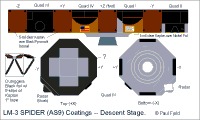

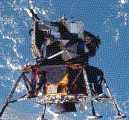
LM-4 (AS 10 Snoopy) had basically the same Ascent Stage pattern as Eagle except that, instead of the beige 5056, everything was heavy 2024 (silver). The Descent Stage was mostly black on top and on the sides with Nickel foil on the bottom. Lower outriggers were bagged with 5 mil aluminized Kapton.
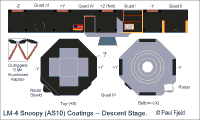
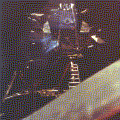
LM-6 (AS 12 Intrepid) sported the final look of the Ascent Stage (see LM-10 below but with no white panels). The Descent Stage was nearly identical to Eagle except that Quad 1 had less black (see LM-7). This magnificent view by Pete Conrad reveals some tremendous detail of the spacecraft. You can even see the little rip in the Hatch shield panel that Conrad punched with his PLSS - it's a horizontal line midway up and to the left on the Hatch. Guy on the ladder is Al Bean.

LM-7 (AS 13 Aquarius): the one Hollywood got wrong. Ascent & Descent Stages like Intrepid; gear like Antares. This Grumman picture shows the Descent Stage Quad 1 during on the weight and balance rig. Note that the lighter kapton over the S-Band container was covered by a final 5 mil Kapton sheet. This and the LM-6 Quad 1 were identical.

LM-8 (AS 14 Antares) was the odd one. "Gold" Descent Stage and "bare" legs. The photo on the left shows its hatch at Grumman on 11/08/69, twelve days before Intrepid landed on the moon and Conrad ripped his hatch. The photo in the middle shows Antares at Fra Mauro on 02/05/71 with a new, thicker and all 2024 hatch. Engineers even added a little recessed door handle in the middle.
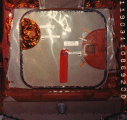
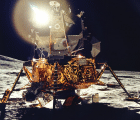
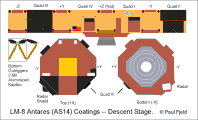
These Quad 3 photos show the look of the Inconel #600 foil painted with Pyromark Black. The paint was baked (or vitrified) and small flaws were sprayed black, leaving dark blotches. You can see them in both the pre-flight and moon shots. Notice the Kapton tape strips everywhere, sealing any stitching or stapling, or anything else the thermal techs could find.
Ascent Stage Shield panels were generally 4 mil Aluminum sheets riveted to a stronger (2024?) frame which was screwed onto a few non-conductive stand-offs beneath the shield. Notice that some of the frames look gray and some silver (chromic and sulfuric anodizing?). On the left is a perfect view of four different shields side by side - clockwise from the middle black panel: Pyromark Black painted Inconel #600, Sulfuric Acid Anodized 2024, Chromic Acid Anodized 5056 and Chromic Acid Anodized 2024. On the right shot, peeking out from beneath the tank panels is the Fuel Fill & Drain with its 5 mil Aluminized Kapton blanket.
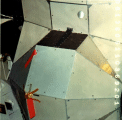
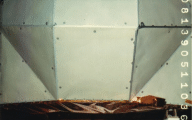
Here's a terrific shot of the Oxidizer tank shielding and the Fly-away Umbilical Door. The little spigot is, I think, the N2 purge port. In this photo are three of the varieties of fiberglass. The cut-out on the top right corner of the Kapton covered door is a tan Epoxy Fiberglass, I think the same as what the LM-2 through LM-5 porch was made of. The spigot is also Epoxy Fiberglass but lighter in color. This is the same color as the J-LM "door mat" in front of the hatch. The warm white piece that the spigot sits on is Silicone Fiberglass. There is another color to the Epoxy Fiberglass: darker and more red. You can see it on the LM-8 hatch closeup (above) in the hatch-handle "semi-circle" and the "door mat." I have no idea why they are different colors (yet...).
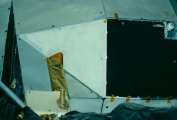
These Upper Outriggers show a nice closeup of one of the four apex pads where the vehicle was tied down to the Spacecraft/LM Adapter (SLA). Those beautifully sculpted parts had to take the load of a full-weight LM at about 8 g's ultimate! The rings inboard of the pads are structural components of the Vent Cuffs, where outgassing from the blankets was diffused. The cuffs were not used on the J-LMs. On the right is the "+Y Do-Hicky," AKA Lower Umbilical. If you model it, take out the red "remove before flight" plugs.
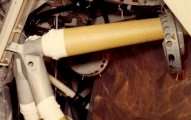
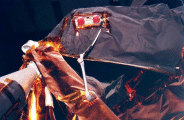
LM-10 (AS 15 Falcon) was the first of the extended Lunar Modules (J mission). Its Ascent Stage (and those of following LM-11 (AS 16 Orion and LM-12 (AS 17 Challenger)) were all essentially identical to LMs 6,7,& 8 - except in one area. Because the LM would stay longer on the moon, Grumman thermal engineers were concerned about the RCS propellant tanks keeping cool enough, so they painted eight shield panels on either side of the Ascent Stage with White Sicon paint to reflect more heat. It worked fine on Apollo 15, but on '16 it peeled. They removed the white paint on Apollo 17 - turns out it only bought them two degrees F. The Descent Stages changed to accomodate all three of the newer packages: a Rover, bigger MESA, and pallet.
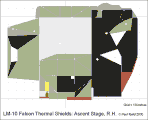
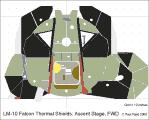
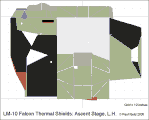
Here are a couple of photos of the J series Descent Stage "secret" areas - the top deck and outboard of the stowed MESA (pyromark black/inconel and 5 mil aluminized Kapton)
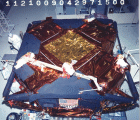
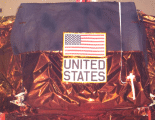
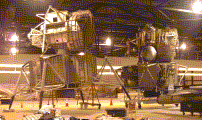
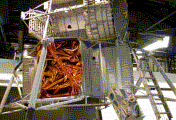
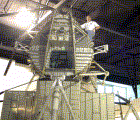
A Final Note to modelersI remember my first LM model. It was the Revell 1/48 kit with the funny Ascent Stage facets and the single, lonely bubble-headed astronaut left behind in the cabin. The spacecraft was white with shiny black bars on the Quads and under the windows. It was bizarre yet beautiful and I fell in love with it (I was 13). I built it in one night in February, 1969. The next month I religiously followed its real cousin on the LM's first manned flight on Apollo 9, imagining the mission with the aid of my scaled talisman. After the mission, when I saw the first photos of Spider published in Time magazine, I had one reaction: "what is that ???" It looked nothing like my model. So began a long quest to make accurate my vicarious adventure.Three years and ten models later, I still didn't have the colors right. And now that I'm a "grown" man, though I'm close, I'm still not sure that I've got every rivet right. Or why it matters. But it does.
Flight photos: NASA, scanned by Kipp Teague LM-3 flight photos scanned by J.L. Pickering LM-9 & LM-13/LTA-1 photos © J. Randy Attwood Last two LM-13 photos © Frank Pullo
© Paul Fjeld
|
